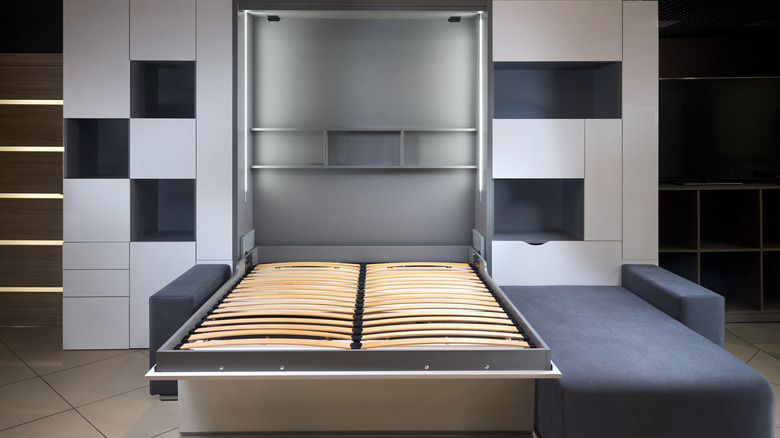How To Determine If A Murphy Bed Will Fit In Your Room
Legend has it that William L. Murphy invented his namesake bed in 1900 so that he could invite the woman he was courting for an overnight stay without committing any improprieties. He probably didn't imagine how his simple solution for maximizing a small space would evolve. Murphy beds are the perfect way to maximize your guest space. While they retain their original purpose as a place to sleep at night that can easily be tucked away during the day, many can now fold into multipurpose cabinets, bookcases, or even low console tables rather than an alcove in the wall. Whether you are DIYing a Murphy bed or buying one premade, determining if you have space for one of these involves measuring all three dimensions of the room.
Unlike standard beds, Murphy beds are upright when they're not in use, so your measurements must include the length, width, and height of the room. If the bed is not going to be built into the wall, you'll also need to account for the depth and width of the cabinet, and the bed frame and mattress it folds into. The bed type is another consideration. Beds that are perpendicular to the wall need more floor space, while a Murphy bed that's parallel to the wall has a less intrusive footprint. These parallel or horizontal beds work well in rooms with low ceilings because they can fold into a shorter cabinet.
Measuring to see if a Murphy bed will fit
Measure the ceiling height first. Almost all Murphy beds will fit in a room with an eight-foot ceiling. If there's a ceiling fan in the room or a sloped ceiling, make sure the bed will clear them as it's being unfolded. Measure the width of the room, keeping in mind that baseboard molding will subtract a couple of inches from a wall-to-wall measurement. Finally, measure the length of the room. Take into account the size mattress you want — a king-sized bed will project almost 87 inches into the room, while a twin mattress is around five inches shorter.
Remember that the Murphy bed is not the exact size of a bed. Even with the most basic Murphy bed, you'll need space for the mechanisms that operate it. You'll also need clearance on three sides. At the foot of the bed, 30 to 36 inches gives you room to maneuver once the bed is unfolded. Ideally, there'd be 24 to 30 inches on each side of the bed to get in and out, though a horizontal bed only needs clearance on one side. Make sure that doors can be opened, radiators and baseboard heaters aren't obstructed, light switches and outlets aren't covered, and that there's space in the room to put things you've had to move to open the bed.
A Murphy bed unit is a piece of furniture, just like your sofa or coffee table. Its purpose is clearly defined as a place to sleep, but the structure that holds it will become a permanent feature of the room. Once you know the measurements, you can make design choices about customizing your Murphy bed with things like cabinet storage or nightstands that deploy when the bed is unfolded.

